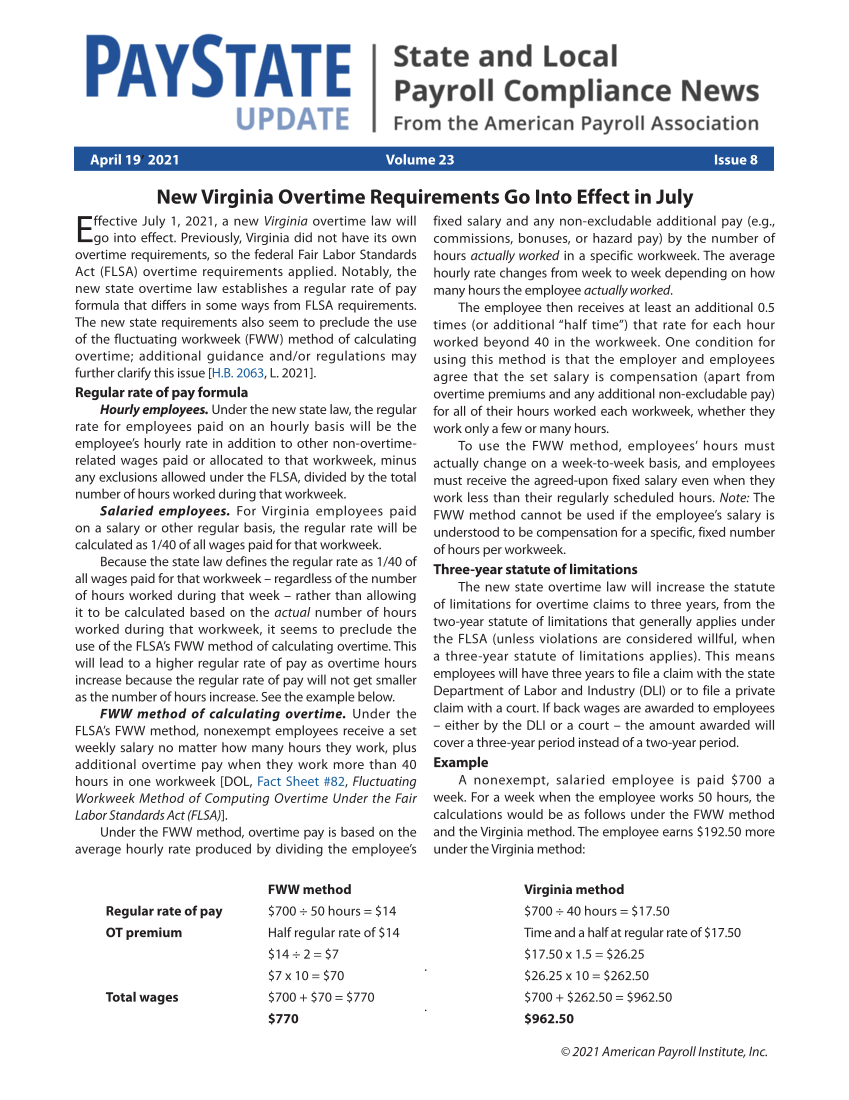© 2021 American Payroll Institute, Inc. New Virginia Overtime Requirements Go Into Effect in July Ego ffective July 1, 2021, a new Virginia overtime law will into effect. Previously, Virginia did not have its own overtime requirements, so the federal Fair Labor Standards Act (FLSA) overtime requirements applied. Notably, the new state overtime law establishes a regular rate of pay formula that differs in some ways from FLSA requirements. The new state requirements also seem to preclude the use of the fluctuating workweek (FWW) method of calculating overtime additional guidance and/or regulations may further clarify this issue [H.B. 2063, L. 2021]. Regular rate of pay formula Hourly employees. Under the new state law, the regular rate for employees paid on an hourly basis will be the employee’s hourly rate in addition to other non-overtime- related wages paid or allocated to that workweek, minus any exclusions allowed under the FLSA, divided by the total number of hours worked during that workweek. Salaried employees. For Virginia employees paid on a salary or other regular basis, the regular rate will be calculated as 1/40 of all wages paid for that workweek. Because the state law defines the regular rate as 1/40 of all wages paid for that workweek – regardless of the number of hours worked during that week – rather than allowing it to be calculated based on the actual number of hours worked during that workweek, it seems to preclude the use of the FLSA’s FWW method of calculating overtime. This will lead to a higher regular rate of pay as overtime hours increase because the regular rate of pay will not get smaller as the number of hours increase. See the example below. FWW method of calculating overtime. Under the FLSA’s FWW method, nonexempt employees receive a set weekly salary no matter how many hours they work, plus additional overtime pay when they work more than 40 hours in one workweek [DOL, Fact Sheet #82, Fluctuating Workweek Method of Computing Overtime Under the Fair Labor Standards Act (FLSA)]. Under the FWW method, overtime pay is based on the average hourly rate produced by dividing the employee’s fixed salary and any non-excludable additional pay (e.g., commissions, bonuses, or hazard pay) by the number of hours actually worked in a specific workweek. The average hourly rate changes from week to week depending on how many hours the employee actually worked. The employee then receives at least an additional 0.5 times (or additional “half time”) that rate for each hour worked beyond 40 in the workweek. One condition for using this method is that the employer and employees agree that the set salary is compensation (apart from overtime premiums and any additional non-excludable pay) for all of their hours worked each workweek, whether they work only a few or many hours. To use the FWW method, employees’ hours must actually change on a week-to-week basis, and employees must receive the agreed-upon fixed salary even when they work less than their regularly scheduled hours. Note: The FWW method cannot be used if the employee’s salary is understood to be compensation for a specific, fixed number of hours per workweek. Three-year statute of limitations The new state overtime law will increase the statute of limitations for overtime claims to three years, from the two-year statute of limitations that generally applies under the FLSA (unless violations are considered willful, when a three-year statute of limitations applies). This means employees will have three years to file a claim with the state Department of Labor and Industry (DLI) or to file a private claim with a court. If back wages are awarded to employees – either by the DLI or a court – the amount awarded will cover a three-year period instead of a two-year period. Example A nonexempt, salaried employee is paid $700 a week. For a week when the employee works 50 hours, the calculations would be as follows under the FWW method and the Virginia method. The employee earns $192.50 more under the Virginia method: FWW method Virginia method Regular rate of pay $700 ÷ 50 hours = $14 $700 ÷ 40 hours = $17.50 OT premium Half regular rate of $14 Time and a half at regular rate of $17.50 $14 ÷ 2 = $7 $17.50 x 1.5 = $26.25 $7 x 10 = $70 $26.25 x 10 = $262.50 Total wages $700 + $70 = $770 $700 + $262.50 = $962.50 $770 $962.50 April 19, 2021 Volume 23 Issue 8
Printed for: PayrollOrg Bookshelf © 2024 American Payroll Institute, Inc. All Rights reserved. From: PayrollOrg Digital Publications (bookshelf.payroll.org)







